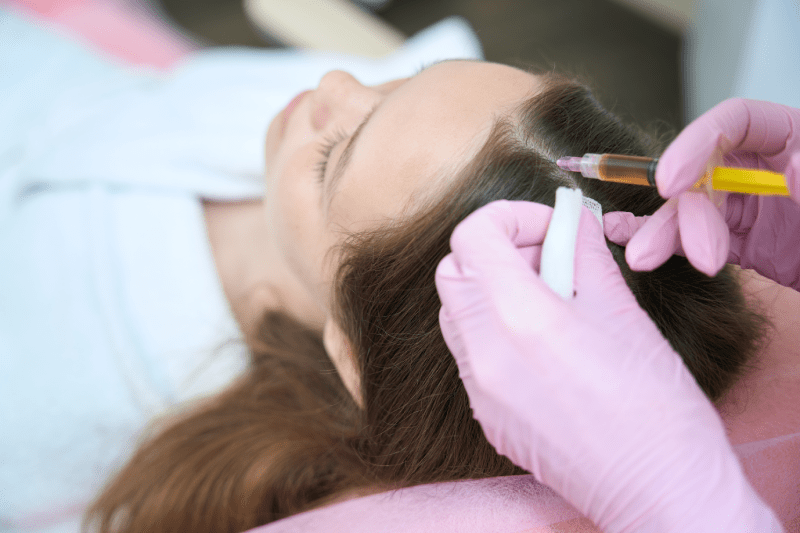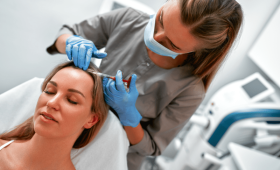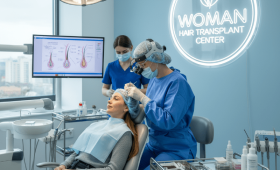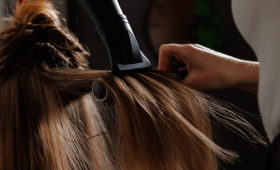How Does The Hair Transplantation Process Start In Women
The hair transplantation process begins with a detailed preliminary analysis and consultation. In this stage, the patient’s type of hair loss (genetic, hormonal, traumatic), the severity of the loss, and most importantly, the quality and density of the donor area (usually the nape of the neck) are evaluated.
Hair root examination, blood test evaluations, and hair analysis are performed. Following this, considering the patient’s expectations and facial features, the hairline design that will yield the most natural result and the appropriate transplantation technique (DHI, FUE) are determined. This meticulous planning forms the foundation for a successful operation and is carried out with great care in clinics in Turkey.
Which Analyses Should Be Performed Before Hair Transplantation
Before hair transplantation, a series of medical analyses must be performed to ensure the operation’s safety and success. These tests are conducted to check the patient’s general health status and to reveal any underlying causes that might affect the transplant outcome. The main analyses include complete blood count, screening for infectious diseases such as hepatitis B/C and HIV. Furthermore, thyroid hormone levels, ferritin (iron stores), and biotin-B12 vitamin levels, which may trigger hair loss, are checked. This comprehensive pre-examination is critical for the team to confirm the patient’s suitability for the procedure.
Who Are The Ideal Candidates For Hair Transplantation In Women
The most ideal candidates for hair transplantation in women are those who typically show a male pattern baldness pattern and have healthy, permanent roots in the nape of the neck. Additionally, women with localized (regional) hair loss due to trauma, burns, or surgical scars who wish to cover these areas are also suitable candidates. Patients whose hair loss progression has stabilized (halted in the last 6 months) achieve more successful results. Patients with widespread and diffuse thinning (equal thinning all over the head) and a weak donor area are generally directed towards medical treatments first.
How Is Unshaven Hair Transplantation Applied And What Are Its Advantages
Unshaven hair transplantation is a method specially applied to alleviate the aesthetic concerns of female patients. In this technique, instead of shaving all the hair, usually only a small, narrow strip of the donor area is shortened, or no shaving is done at all when using the DHI technique to harvest grafts. Since the harvested grafts are carefully placed among the long hair, the transplant area can be easily concealed even on the first day of the operation. The main advantage is that the patient can return to their social life very quickly and without visible changes; this makes it one of the most comfortable transplantation options for women.
Why Is The DHI Technique More Preferred In Women
The DHI (Direct Hair Implantation) technique is frequently preferred in women due to its high precision and minimally invasive features. This method uses a specialized pen (Choi pen) to allow hair roots to be implanted directly, without waiting and without opening channels, immediately after harvesting. This minimizes the time the grafts spend outside the body, maximizing their viability rate.
Especially when transplanting among existing hairs (as in unshaven transplantation), the DHI pen allows the transplantation angle and direction to be more precisely adjusted, resulting in outcomes that are extremely natural and harmonious with the existing hair texture.
What Difference Does The FUE Technique Make In Women
The traditional FUE (Follicular Unit Extraction) technique is still an effective option for women, especially those with a greater need for grafts or those who want to clearly redefine the hairline. In FUE, grafts collected individually from the donor area using micromotors are placed into pre-opened channels in the recipient area.
When FUE is applied to women, a small area of the donor region usually needs to be shaved, but this area can be concealed among long hair. The fast and efficient graft harvesting capacity makes FUE an economical and powerful alternative for covering larger areas of loss.
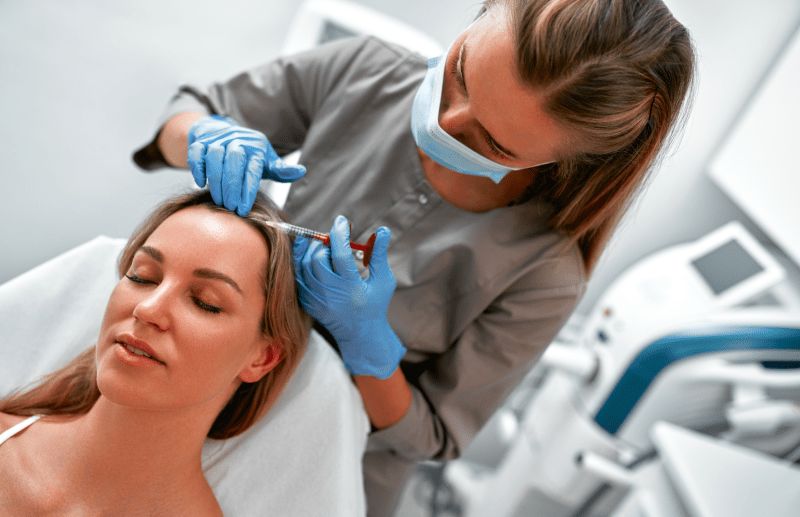
How Should Hairline Design Be Done In Women
Hairline design in women is one of the most critical steps for the aesthetic success of the operation and differs from the male hairline. For a natural appearance in women, the line should be designed in a soft, curved, and slightly rounded form, not sharp and angular like in men. The starting point of the line is determined by considering the patient’s facial features and the movements of the forehead muscles. Furthermore, implanting single hair roots at the very front line and meticulously adjusting the natural exit angles of the hair completely prevents the formation of an artificial “wig” appearance and ensures a natural transition.
What Should Be Considered When Determining The Donor Area
The donor area is the region where hair roots are genetically resistant to shedding and where the harvested roots are dense enough to successfully cover the transplant area. In women, this area is generally the part of the nape between the two ears. Key considerations include: ensuring grafts are harvested homogeneously so that no noticeable thinning occurs in the donor area, and the number of grafts taken does not exceed 20-30% of the donor area’s total capacity. Preserving the quality of the donor area is also vital for potential future transplant needs, and this is a priority for experienced teams.
Is The Graft Harvesting Process Painful
The graft harvesting procedure is one of the initial stages of the hair transplant operation, and since it is performed under local anesthesia, the patient does not feel any pain or discomfort during this process. A slight stinging sensation may be felt during the application of the local anesthetic, but this ensures a comfortable experience for the rest of the procedure. Modern clinics in Turkey can even make the anesthesia application more comfortable by using advanced methods like needle-free injection devices. Slight tension or sensitivity may occur after the operation, but this can be easily managed with prescribed pain relievers.
How Long Do Hair Roots Remain Outside The Body
The time hair roots (grafts) spend outside the body after harvesting is a critical factor for their viability and successful engraftment. It is considered ideal that the time grafts remain outside does not exceed 4 to 6 hours. During this period, the roots are nourished and protected from damage by being stored in specially prepared hypothermic solutions at a specific temperature. The DHI technique, in particular, has the advantage of minimizing this time by performing the graft harvesting and implantation almost simultaneously, thereby maximizing the vitality of the roots and directly impacting the success of the transplant.
How Is The Channel Opening Procedure Performed Before Transplantation
The channel opening procedure before implantation is a critical stage applied only in the FUE technique that prepares the sites where the grafts will be placed. These channels determine the natural exit direction, angle, and depth of the hair roots, making this one of the most crucial steps for a natural result. Today, this procedure is generally performed using Sapphire-tipped blades, which are finer and less traumatic. Sapphire blades create micro-incisions, reducing tissue damage, minimizing bleeding, and accelerating the healing process, while allowing for denser implantation.
How Is The Correct Angle Of Hair Roots Determined
The correct angle and direction in hair transplantation require an artistic skill to ensure the final result looks completely natural. Hair naturally grows at different angles in each area: narrower angles (15-20 degrees) are used at the frontal hairline, and steeper angles (40-60 degrees) are used on the top part. Experienced teams determine the angle by observing the natural exit directions of the patient’s existing hair before the transplant, guiding the placement of grafts with the channels or the DHI pen. This precision guarantees that the transplanted hairs blend perfectly with the other hair and are manageable, eliminating any artificial or flat appearance.
How Many Hours Does The Hair Transplantation Surgery Take In Total
The total duration of the hair transplantation surgery varies depending on the number of grafts to be transplanted, the chosen technique (DHI may take slightly longer), and the patient’s general condition. Generally, a hair transplantation procedure, including preparation, anesthesia, graft harvesting, channel opening, and implantation stages, takes between 6 to 8 hours. This long process is supported by short breaks to maintain both the team’s focus and the patient’s comfort. Experienced teams in Turkey aim to manage this process most efficiently to achieve both fast and high-quality results.
How Is Anesthesia Applied And Does It Have Side Effects
The hair transplantation operation is performed with local anesthesia, which only numbs the scalp. General anesthesia is not used. Anesthesia is applied via injection to both the donor and recipient areas, ensuring the patient feels no pain throughout the entire procedure. A mild burning or stinging sensation may be felt during the injection. Modern clinics may use pressure-based needle-free devices to minimize this discomfort. While local anesthesia does not have serious side effects, allergic reactions or temporary dizziness can rarely occur; these are easily managed by the operating team.
What Does The Patient Feel During The Operation
After the local anesthesia is applied, the patient feels no pain or discomfort during the operation. Patients typically spend this long period relaxing, reading a book, watching a movie, or using their phones. It is normal to feel a slight pressure, vibration, or touch sensation during the operation, but these are not painful. Patient comfort is kept at the highest level, and additional breaks or anesthesia top-ups can be provided if needed. Clinics in Turkey take care to use comfortable and ergonomic treatment chairs to ensure patients have a relaxed experience.
What Should Be Considered In The First Two Days After Hair Transplantation
The first 48 hours after hair transplantation are the most critical period for the transplanted grafts to settle and begin vascularization. During this time, any impact, friction, or pressure that could damage the grafts must be avoided. The patient must pay special attention to their sleeping position, lying on their back with their head elevated using a special neck pillow. Bending over, heavy lifting, or intense physical activity are strictly forbidden. Additionally, the transplant area must be kept dry and clean, and the doctor’s prescribed medications and lotions should be used regularly.
When And How Should The First Wash Be Done
The first wash after hair transplantation should generally be performed on the 3rd or 4th day after the operation, carried out by the clinic that performed the transplant or an experienced nurse. This wash is done with great care to gently clean the clotted blood and scabs in the transplant area and ensure the grafts are not damaged. The patient is thoroughly instructed on how to apply the special pH-balanced shampoo and lotion they will use at home, and how to wash with very gentle movements, without applying pressure with fingertips, to massage the area. This delicate process directly affects the survival rate of the grafts.
What Is Shock Loss And When Does It Start
Shock loss is a natural process that begins approximately 2 to 8 weeks after the hair transplantation surgery, in which the transplanted hair strands temporarily shed. This is a normal biological reaction of the hair roots to the trauma experienced during the transplantation and signals the roots entering the resting (telogen) phase. Shock loss can be worrying for patients, but it must be remembered that only the hair strand sheds, while the healthy roots remain beneath the scalp. This process is considered a preparation phase that makes room for new, permanent hair growth.
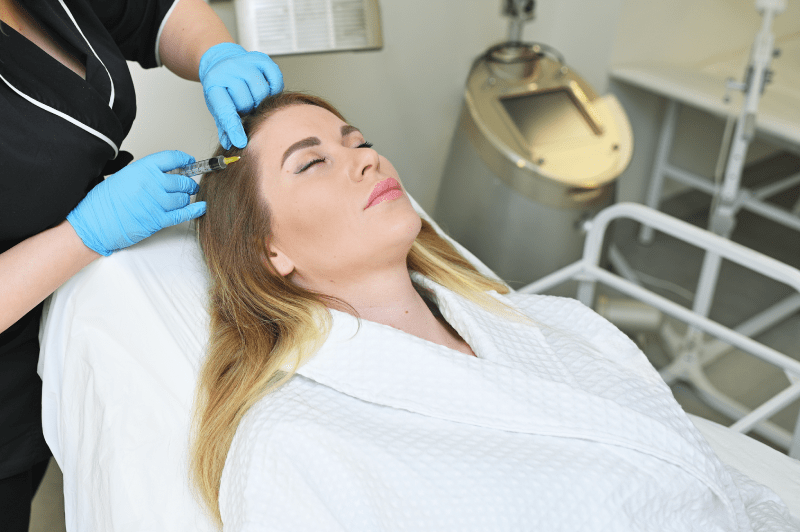
Does Shock Loss Cause Permanent Hair Loss
No, shock loss does not cause permanent hair loss; on the contrary, it is a natural part of permanent and healthy hair growth. During shedding, the hair follicle itself (the hair root) remains firmly in the scalp, and only the hair strand above it is shed. After the root exits this resting phase, it reactivates within about 3 to 4 months and begins to produce new, thick, and permanent hair strands that will not shed. It is important for patients not to view this period as a failure, to be patient, and to continue with supportive treatments.
How Are Scabs Formed After Hair Transplantation Cleaned
The scabs that form in the transplanted area during the first week after hair transplantation are a natural part of the healing process and protect the grafts. To clean these scabs, special softening lotions obtained from the clinic are typically used between the 7th and 10th days. The lotion is applied generously to the transplanted area and left for 30-60 minutes to soften the scabs. Then, using lukewarm water and special shampoo, the scabs are removed gently massaging with fingertips without rubbing. Clearing all scabs by the 10th day is a critical step as it facilitates the emergence of new hair.
What Is The Growth Rate Of Newly Transplanted Hair
The permanent hair that grows from the newly transplanted hair roots usually begins to appear after the shock loss period, starting from the 3rd month of the operation. Initially, these hairs may be fine, wispy, and weak, but they thicken and strengthen over time. Approximately 50% of the hair will have grown within the first six months. The growth rate and quality increase after the 6th month. The hair grows at an average rate of 1 cm per month. This growth is completed within a period of 12 to 18 months, reaching the final, mature, and densest result of the hair transplant.
How Long Does It Take To See The Full Results Of Hair Transplantation
For the results of hair transplantation to be fully assessed and the final, full appearance to be achieved, it is a long-term process that takes an average of 12 to 18 months. The first 3 months are marked by shock loss, while new hair begins to become visible starting from the 4th month. Patients generally see a significant difference by the 6th month, but the hair has not yet reached its full thickness. The complete maturation, thickening of the hair, and all roots reaching their final appearance usually takes until the end of the 1st year and the 18th month. During this time, patience and adherence to the doctor’s advice are essential.
Are The Transplanted Hairs Permanent For Life
Yes, the hair roots transplanted through hair transplantation, as long as correct techniques are applied, are permanent for life. The reason for this permanence is that the hair roots selected as the donor area (the nape and area above the ears) are genetically resistant to the dihydrotestosterone (DHT) hormone. These roots maintain their resistant properties even in the new area where they are transplanted and become immune to shedding. This genetic feature makes hair transplantation the most reliable and continuous treatment method for women experiencing permanent hair loss.
What Are The Supportive Treatments That Increase Hair Transplantation Success
Supportive treatments after the operation are of great importance for maximizing the permanent success of hair transplantation. These primarily include PRP (Platelet Rich Plasma) and Hair Mesotherapy, which increase blood circulation in the transplant area and nourish the roots. These treatments accelerate healing while supporting the engraftment rate of the transplanted grafts and the thickening of existing hair. Additionally, the regular use of oral supplements containing biotin, zinc, and Vitamin D and other special hair vitamins, recommended by the doctor, also helps improve the quality of the transplant outcome.
Why Is PRP Treatment Important After Transplantation
PRP (Platelet Rich Plasma) treatment offers strong support to accelerate the healing process and increase transplant success after hair transplantation. When plasma, enriched with growth factors derived from the patient’s own blood, is injected into the transplanted area, it stimulates tissue regeneration. These growth factors accelerate the vascularization of the newly implanted grafts, revitalize the stem cells, and help the hair follicles enter the growth phase faster and healthier. It is usually applied in periodic sessions, starting shortly after the operation.
When Can Sports And Exercise Be Resumed After Hair Transplantation
The timing for resuming sports and exercise after hair transplantation should be gradual to ensure the safety of the transplanted grafts. For the first 5 days, any strenuous physical activity that causes sweating must be strictly avoided to prevent the grafts from shifting. Light exercises like walking can generally be resumed after 5 to 7 days. However, it is recommended to wait for at least 3 to 4 weeks for heavy lifting, intense cardio, or sports that carry a risk of impact to the head area (like basketball, football, etc.). This waiting period is vital for the grafts to fully settle and take hold.
Why Is Smoking And Alcohol Consumption Forbidden After Hair Transplantation
Smoking and alcohol consumption after a hair transplantation operation severely compromise the healing process and are therefore strictly forbidden. Smoking, due to the nicotine it contains, narrows blood vessels, which prevents sufficient oxygen and nutrient flow to the newly transplanted hair roots, lowering the survival rate and slowing wound healing. Alcohol, on the other hand, acts as a blood thinner, increasing the risk of bleeding and potentially interfering with medications. Abstaining from these substances for at least one week before and two weeks after the operation is essential for a healthy and successful recovery.
How Long Should Protection From Sun And Seawater Last
Protecting the sensitive scalp after transplantation is important, especially to reduce the risk of infection and pigmentation (discoloration). Direct exposure of the transplanted area to sunlight can lead to permanent discoloration. Therefore, protection from the sun is mandatory for the first month after the operation; a loose cap or hat that does not put pressure on the transplanted area should be worn when going outside. Since seawater and pool chemicals carry an infection risk, these environments should also be avoided until the wound is completely healed, which usually means for at least 3 to 4 weeks, for a complete recovery.
When Is It Safe To Have Sexual Intercourse After Hair Transplantation
Returning to sexual activity after a hair transplantation is important regarding the safety of the grafts. Increased heart rate and sweating during sexual intercourse can affect blood circulation in the transplanted area and slightly increase the risk of infection. It also carries the risk of accidental impact or friction to the head area. To minimize these risks, specialists advise avoiding sexual activity for the first 5 to 7 days after the operation. After this critical period, normal activities can be resumed carefully, as the grafts will have settled.
How Long Should One Wait For Hair Dyeing And Chemical Processes
Due to the sensitivity of the transplanted and donor areas, patience is required for chemical processes after hair transplantation. It is generally recommended to wait for at least one month for lighter procedures like hair dyeing. This period is necessary for the scalp to fully heal and for the grafts to be firmly secured. For procedures involving stronger chemicals, such as bleaching or perming, it is safest to wait for a period of two months or longer to ensure all sensitivity in the scalp has passed. Failure to comply with these restrictions can cause permanent damage to the transplanted roots.
What Are The Rules For Transportation And Travel After Hair Transplantation
Travel rules are important for patients who have hair transplants in Turkey, as most come from abroad. Since the first 72 hours are critical for graft survival, patients need to stay close to the clinic. They are generally allowed to travel after the 3rd or 4th day, following the first wash. During travel, a special neck pillow should be used to protect the transplanted area from friction, and contact with the headrest of the car seat should be avoided. Air travel does not pose a risk to the grafts, but attention must be paid to hygiene and protection against impacts.
What Are The Most Important Factors Affecting Hair Transplantation Prices
Hair transplantation prices vary significantly depending on various factors. The most important factors are the number of grafts to be transplanted (severity of loss), the preferred transplantation technique (DHI is usually more costly than FUE), and the experience and expertise level of the operating team. Furthermore, all-inclusive packages (accommodation, transfer, medications) offered in countries prominent in health tourism like Turkey also affect the total cost. Turkey is a global attraction center because it offers high quality at more affordable costs compared to Western countries.
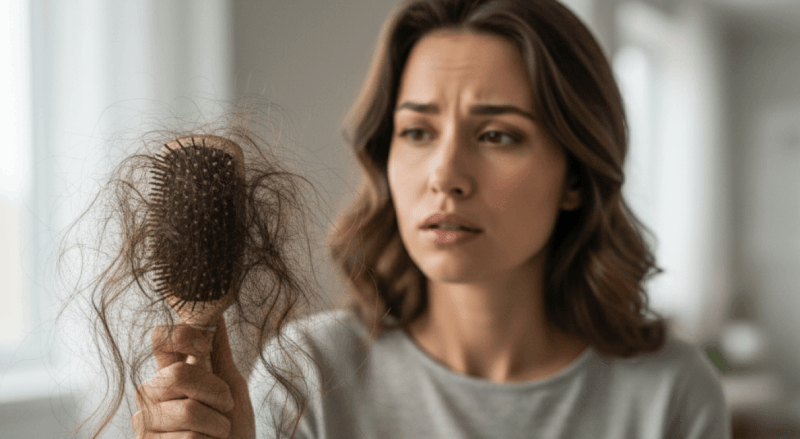
Why Should Turkey Be Preferred For Hair Transplantation
Turkey ranks first globally due to its global experience and technological advancements in the field of hair transplantation. Clinics in Turkey specialize in applying the latest techniques like DHI and Sapphire FUE with high success rates. Despite the high quality of service, the fact that costs are much more affordable compared to Europe and North America is a major advantage for women seeking an economical solution. The experience of specialized teams and the comprehensive service packages offered to international patients make Turkey a reliable and attractive option.
How Does Cure Holiday Help In The Turkey Process
For women considering hair transplantation in Turkey, Cure Holiday is a professional guide that organizes the entire process from start to finish. Cure Holiday collaborates with Turkey’s most experienced centers that are best suited to the patient’s needs. The turnkey packages it offers include not only the operation but also airport pickups, luxury accommodation, interpreting services, and regular post-operative follow-ups. This allows the patient to focus entirely on their recovery and comfort, rather than dealing with the logistical details of overseas travel and treatment processes.
Which Medications And Supplements Should Be Used After Hair Transplantation
After hair transplantation, a protocol of medications and supplements is prescribed by the doctor to support healing and optimize new hair growth. In the first few days, pain relievers and anti-edema medications are used to control pain and reduce swelling (edema). Antibiotics are given for a short period to prevent the risk of infection. In the long term, the regular use of oral supplements containing biotin, zinc, iron, and special hair vitamins is strongly recommended to strengthen the transplanted and existing hair. These supplements help the new hair grow thicker and faster.
What Kind Of Treatment Plan Is Required For The Protection Of Existing Hair
Hair transplantation only restores lost hair; protecting existing hair prone to shedding requires a separate plan. This plan typically involves supportive treatments like PRP and Mesotherapy, which nourish and strengthen the hair roots. Additionally, topical medications like Minoxidil, applied under the doctor’s supervision, help prolong the hair’s growth phase and slow the rate of genetic shedding. Lifestyle changes like balanced nutrition and stress management also play a significant role in preserving existing hair; this holistic approach guarantees long-term success.
When Is A Second Hair Transplantation Operation Necessary
A second hair transplantation operation is usually considered to increase the density of the results obtained from the first operation or to cover new gaps due to ongoing shedding after the first transplant. The most appropriate time for a second transplant is when the final result of the first operation is fully visible, which is usually at least 12 to 18 months later. During this period, the donor area must fully heal, and the root reserve needs to be reassessed. The decision for a second session is made by specialists based on the patient’s need and the amount of usable graft stock in the donor area.
What Are The Hair Transplantation Failure Rates And Their Causes
The success rate of hair transplantation with modern techniques is very high, but there is still a low rate of failure risk. The main reasons for failure include human error such as grafts being implanted at the wrong angle or depth due to an inexperienced team, grafts losing viability from being left outside for too long. Furthermore, the patient not adhering to post-operative instructions (smoking, alcohol, impact) or the development of a serious infection in the transplant area can also lead to failure. Top-tier centers in Turkey minimize these risk factors through strict protocols and hygiene, aiming for a high graft survival rate.
When Can Hair Cutting Be Done After Hair Transplantation
Hair cutting after hair transplantation should be done gradually to allow the transplanted and donor areas to fully heal. Grafts take about 10 days to fully settle. Therefore, it is essential not to touch the transplanted area with scissors or clippers for the first one month. The growing parts of the hair can be shortened with scissors, but the transplant area should not be touched. For shortening the hair in the donor area with a hair clipper, it is generally recommended to wait for at least two months, which is a safe period for scars to disappear completely.
Is A Permanent Thinning Visible In The Donor Area
In hair transplants performed by professional and experienced teams, no noticeable permanent thinning occurs in the donor area. The reason for this is that grafts are harvested homogeneously and sparsely at a rate of only 20% to 30%. The remaining hair grows out after some time, naturally covering the empty spaces where the roots were taken. Thinning may be a risk if excessive harvesting is mistakenly done or if the wrong punch thickness is used in the FUE technique. However, specialized centers in Turkey adopt the preservation of the aesthetic integrity of the donor area as a core rule.
How To Cope With The Psychological Effects Of Hair Loss
Hair loss in women can lead to serious emotional effects such as loss of self-confidence, social withdrawal, and psychological stress, not just physical changes. The first way to cope with this situation is to take a concrete step, such as hair transplantation, which offers a permanent solution to the problem. Seeking support from a psychologist or counselor during the treatment process can help alleviate the emotional burden. Achieving the expected look after hair transplantation generally quickly removes the psychological pressure on patients and helps rebuild their self-confidence, significantly improving their quality of life.
What Is The Best Time For Hair Transplantation
Hair transplantation surgery can technically be performed successfully in any season of the year. However, some seasons may be more advantageous for recovery. Autumn and Winter months are generally considered ideal due to lower sunlight intensity and less sweating. This makes it easier to protect the transplanted area from the harmful effects of the sun and the risk of infection. Transplantation can also be done in the summer, but the patient must be more careful and meticulous about avoiding the sun and heavy sweating.
Will Massaging After Hair Transplantation Damage The Grafts
During the first critical period after hair transplantation, which is approximately the first 10 days, touching, pressing, or harshly massaging the transplanted area will definitely damage the grafts and cause them to shift. The first 10 days are a sensitive process during which the grafts firmly settle into the scalp. However, after the 10th day when the scabs are cleared, gentle fingertip massages can potentially contribute to accelerating hair growth by increasing regional blood circulation. Massage increases blood flow and oxygen supply to the scalp, allowing the newly transplanted and awakening hair roots to receive more nutrients. However, it is important that these massages do not involve excessive pressure or rubbing and are performed only for the duration and intensity permitted by the doctor.
When Should A Dermatologist Be Visited For Hair Loss
It is important to visit a dermatologist or hair loss specialist as soon as you notice that hair loss is increasing at an unusual rate, that regional loss is occurring, or that the shedding has lasted longer than two months. If there are signs of inflammation, redness, or severe itching on the scalp, this may indicate an underlying medical issue. Early diagnosis is vital for controlling hormonal imbalances or genetic shedding before they advance and for initiating appropriate medical treatments promptly. The decision for hair transplantation is also usually made after a dermatological evaluation.
What Are The Right Hair Washing And Drying Techniques Against Hair Loss
For women experiencing hair loss, washing and drying techniques should minimize stress on the hair strands. Hair should be washed with lukewarm water instead of very hot water and with gentle movements. When applying shampoo, the scalp should be massaged with the soft part of the fingertips, not the nails. Wet hair is very fragile; therefore, instead of roughly rubbing the hair with a towel during drying, the moisture should be removed by lightly pressing the towel onto the hair. If a hairdryer is used, the lowest heat setting should be chosen and kept away from the scalp to help reduce heat damage and, consequently, breakage.
Might Another Hair Transplantation Be Necessary After The First One
The first hair transplantation operation generally aims to provide satisfactory results in a single session. However, a second session may be needed if the patient’s genetic shedding progresses or if the desired density is not achieved after the first transplant, necessitating the closure of new gaps. The decision for a second transplant is usually made 12-18 months after the final result of the first operation is seen. This second transplant is typically performed to reinforce newly thinned areas or further increase the density of the existing transplant area, and it depends on the availability of sufficient healthy root stock in the donor area.
What Are The Failure Rate Of Hair Transplantation And The Causes
The success rates of hair transplantation with modern FUE and DHI techniques are high. Low failure rates are generally due to human error or post-operative negligence. Causes of failure include grafts losing viability from being left outside for too long, the team using the wrong technique or angle, and most importantly, the patient not adhering to recovery instructions regarding smoking, alcohol, impact, or sun exposure. Experienced centers in Turkey minimize these risk factors through strict protocols and the latest technology, aiming for a high graft survival rate.
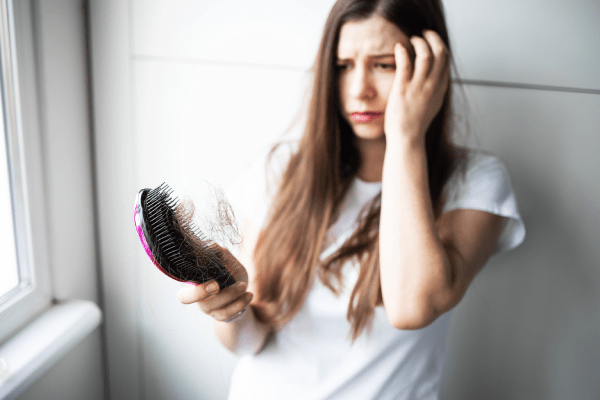
What Are The Side Effects Of Medications Used For Hair Loss In Women
Topical medications like Minoxidil used for hair loss in women can have some side effects. The most common side effects of Topical Minoxidil use are itching, redness, irritation in the application area, or rarely, increased hair growth in unwanted areas like the face. Less common but more serious side effects can include dizziness or changes in hormonal balance. It is mandatory for patients to consult their doctor immediately if they observe any side effects and receive professional medical guidance before discontinuing the medication, ensuring a safe and effective treatment process.
How Should Lifestyle Be Regulated Before Starting Hair Loss Treatment
Lifestyle adjustments before and after hair transplantation play a fundamental role in enhancing treatment success. Prioritized for hair health are managing chronic stress and getting sufficient, quality sleep. Eating habits should be reviewed; a balanced diet rich in protein, zinc, iron, and B vitamins should be adopted. Habits that negatively affect blood circulation, such as smoking and alcohol, must be strictly given up before the operation. This healthy lifestyle strengthens hair roots and increases the chance of transplant success.
When Can Hair Dyeing And Chemical Processes Be Done After Hair Transplantation
Due to the sensitivity of the transplanted and donor areas, patience is required for chemical processes after hair transplantation. It is generally recommended to wait at least one month for lighter procedures like hair dyeing. This period is necessary for the scalp to fully heal and for the grafts to be firmly settled. For procedures involving stronger chemicals, such as bleaching or perming, it is safest to wait for a period of two months or longer to ensure all sensitivity in the scalp has passed. Failure to comply with these restrictions can cause permanent damage to the transplanted roots.
How Should Closed Areas And Hat Use Be Managed After Hair Transplantation
Hats or head coverings used to protect the transplanted area in the first few days after hair transplantation must never be tight or restrictive. Pressure can cause the implanted grafts to shift. For the first 10 days, generally only special, loose surgical caps provided by the clinic, which do not contact the transplanted area, should be used. After this period, softer, breathable, and non-rubbing head coverings like beanies or loose hats can be worn. As long as hygiene is maintained in closed areas, there will be no issue.
How Successful Are Hair Transplantation Results In Advanced Ages
Hair transplantation can yield successful results even in advanced ages; the critical factor is not the patient’s chronological age, but the quality of the hair roots in the donor area. If there is sufficient healthy graft stock with adequate density in the nape area, aesthetically satisfying results can be achieved in older patients as well. However, due to factors like decreased skin elasticity and slower cellular healing with age, the recovery process may be slightly longer than for younger patients. It is essential for older patients to have their general health status and chronic diseases under control for a successful outcome.
What Is The Importance Of A Personalized Approach In Hair Loss Treatment
The personalized approach in hair loss treatment is indispensable because every individual’s cause of shedding and hair structure is different. Instead of a standard treatment protocol, a plan should be created by considering the patient’s special blood test results, hair analysis results, lifestyle, and expectations. This personalization ensures not only the selection of the correct transplantation technique (DHI or FUE) but also the adjustment of medical supportive treatments (PRP, vitamin supplements) before and after the operation according to the patient’s specific needs. This holistic and individualized plan guarantees the permanent success of the treatment.
Does Having Hair Transplantation Prevent Existing Hair From Shedding
Hair transplantation guarantees that the transplanted roots will not shed for life, but it does not prevent the shedding of existing, non-transplanted hair. If the patient’s genetic or hormonal predisposition continues, existing hair in non-transplanted areas may continue to thin over time. Therefore, even after a successful transplant, it is strongly recommended to continuously use Minoxidil, PRP, or Mesotherapy and other supportive treatments under a specialist’s supervision to protect and strengthen the existing hair. The transplanted hair is permanent, but other hair must be preserved.
Can Hair Growth Be Accelerated With Massage After Hair Transplantation
After the first critical 10-day period following hair transplantation is completed and the scabs have shed, gently massaging the transplanted area with fingertips can potentially contribute to accelerating hair growth. Massage increases blood circulation and oxygen flow in the scalp, enabling the newly transplanted and awakening hair roots to receive more nutrients. This can help the hair enter the growth phase faster. However, it is important that these massages do not involve excessive pressure or rubbing and are performed only for the duration and intensity permitted by the doctor.
In Which Cases Should A Doctor Be Consulted Immediately After Hair Transplantation
Certain unexpected symptoms after hair transplantation may require immediate medical attention. Patients should contact the clinic immediately if they notice severe, persistent pain, high fever, dense and foul-smelling discharge, excessive swelling (edema), or much more bleeding than normal in the transplanted and donor areas. These symptoms may be signs of infection or a serious complication. Professional Hair transplant centers in Turkey provide 24-hour accessible support lines after the operation, ensuring patients report and manage such situations as quickly as possible.
How To Start The Hair Transplantation Process In Turkey
To start the hair transplantation journey in Turkey, the first step is to contact a reliable health tourism intermediary agency like Cure Holiday. Initially, the patient shares photos showing their hair loss status and medical history online. Cure Holiday forwards this information to specialist doctors in Turkey to create a personalized free preliminary analysis and treatment plan. Once approved, the operation date is set, and all logistical details such as accommodation, airport transfers, and interpreter services are organized by Cure Holiday, ensuring the patient can start the treatment stress-free.
Hair Transplantation in Turkey: Your Reliable Address for Permanent Solutions
Hair transplantation in women is an aesthetic and permanent solution to the problem of permanent thinning and hair loss. Turkey is the number one health tourism destination worldwide, thanks to its technological superiority, experienced surgical teams, and cost-effective advantages in this field.
When making this important decision, you want to ensure that every stage of the process is professionally managed. Cure Holiday will guide you to reach the best and most reliable hair transplantation centers in Turkey, managing your travel, accommodation, and all post-operative follow-ups centrally.
Hair transplantation has the potential to restore not only your hair but also your self-confidence and quality of life. Contact Cure Holiday today to take the first step in this transformation journey in Turkey and achieve natural, dense hair.
